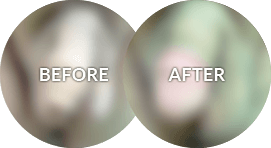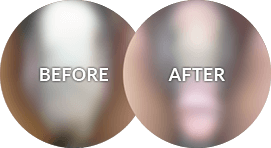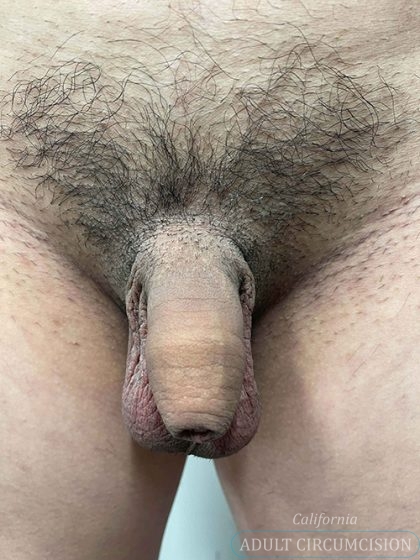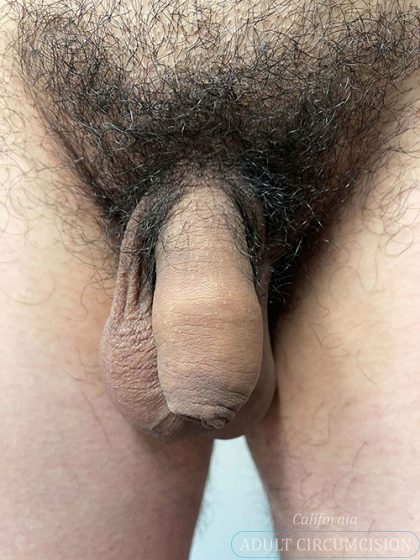Pain during an erection is an abnormal occurrence that requires further examination by your urologist. An underlying genitourinary concern such as Peyronie’s disease, or systemic illness can cause symptoms that result in painful erections. Additionally, physical trauma affecting the inner or outer anatomy of the penis can cause acute or prolonged soreness. Receive prompt evaluation and treatment for painful erections at Alvarado La Mesa Urology Center. As an American Board of Urology Diplomate, and Former Assistant Professor of Urology at UCSD, Dr. Mo Bidair is at the forefront of urological care in Southern California. Book a personal consultation to address your concerns by calling (619) 486-5005, or by completing a brief inquiry form.
Contents
Before and After Photos
About Erection Pain
Discomfort during arousal is an obvious concern for any man. It can interfere with the ability to enjoy intercourse and can sometimes be difficult for some men to discuss with their sexual partner. Whether the pain can be traced to a specific area, or if it is present throughout the penis, patients should not fear seeking help for erectile pain. And, as professionals, doctors have to reach a diagnosis quickly to provide the most effective treatment. For example, in cases of priapism, painful, long-lasting erections require immediate medical intervention. The key to resolving this issue is a patient’s ability to approach their health in this area as they would any other part of their body. That means getting in touch with a healthcare professional to resolve the issue.
Healthy Erections
Erections are triggered by the parasympathetic nervous system and controlled by the release of the male sex hormone testosterone. They are a natural response to arousing stimuli, but they can also occur spontaneously, without any sexual stimulation. During an erection, the shaft of the penis becomes engorged with blood, causing the inner tissues to swell and harden, and the penis to stand erect.
Erectile Dysfunction
Erectile dysfunction (ED), the inability to achieve or sustain an erection, is the most common penile disorder. (1) But there are other medical conditions that are often more likely to be the main cause of erection pain. If you experience uncomfortable arousal, you may have concerns about sexual function, genitourinary health, and your overall health. That’s why it is important to overcome any embarrassment and speak to a professional.
Anatomy of the Penis
Prepuce – Prepuce is the medical name for the foreskin. Many Americans are circumcised in infancy, but some men choose adult circumcision later in life for cosmetic or medical reasons. In intact patients, physical issues with the foreskin may cause erectile pain.
Glans – The glans is the head of the penis. The physical interaction between the penis and uncircumcised foreskin can affect how comfortable your erections are, particularly if there is localized swelling or foreskin tightness.
Urethra – The urethra is a dual-purpose tube running lengthwise through the middle of the shaft that functions as a passage for urine and semen. The urinary tract, like any other area of the body, is susceptible to bacterial infection and subsequent discomfort.
Corporeal Bodies – The corporeal bodies are spongy, column-like structures within the penis that play an important role in creating an erection. There are three in total. The corpus spongiosum is a single structure that provides erectile support and keeps the urethra open during arousal. Above the urethra, the two larger corpora cavernosa (singular: corpus cavernosum) contain blood vessels that become engorged when an erection occurs.
Tunica Albuginea – The tunica albuginea is a fibrous membrane between the corporeal bodies and the penile skin. This tissue should be very elastic, to allow for the swelling of erectile tissues. However, when the tunica albuginea is damaged, this could cause pain during an erection, and indicate a condition known as Peyronie’s disease.
Find out more about penis anatomy and circumcision options by reading Dr. Bidair’s blog.
Peyronie’s Disease
Peyronie’s disease (PD) is a condition that causes the penis to curve. It is thought to be a trauma-based condition caused by overzealous sexual intercourse, although sports injuries and other repeated penile trauma have also been known to cause it. In fact, many patients cannot recall any single injury of significance, even after their diagnosis!
Peyronie’s disease is a connective tissue disorder. Repeated injury causes disruption in the penile tissues. This creates fibrous plaques – thickened connective tissue that causes unnatural curvature in the shaft. These plaques are a result of collagen and fibrin deposits in the tunica albuginea of the penis. (2)
Symptoms of Peyronie’s Disease
- Significant Bend in Shaft
- Presence of Scar Tissue
- Pain When Flaccid
- Pain When Erect
- Pain That Varies in Intensity
- Erectile Dysfunction
- Penis Appears Shorter
In men with Peyronie’s disease, penile pain is not always present, but it is certainly one of the most frustrating aspects of the condition. Around half of men with PD have depressive symptoms and up to 80% express distress with the condition. Research data shows that penile pain is the first symptom in 39% of men with PD. (2)
Other Causes of Erectile Pain
Phimosis & Paraphimosis
Phimosis and Paraphimosis occur when the foreskin is too tight, restricting and causing pain in the glans. Physical phimosis is usually corrected soon after it is identified at birth, however, pathological phimosis can be a painful result of penile trauma. Paraphimosis is an emergency condition where the foreskin becomes trapped behind the glans, requiring immediate medical attention.
Balanitis
Balanitis is inflammation of the glans. A related condition, balanoposthitis, involves both glans and foreskin inflammation, and is present in around 6% of balanitis cases. (4) Infection in this area is associated with pain, and urinary tract infections (UTIs). With recurrent balanitis, Dr. Bidair may recommend a circumcision procedure.
Penile Fracture
Sometimes referred to as a “broken penis”, a penile fracture is most commonly the result of injury during intercourse. In fact, in almost 60% of cases, direct trauma to the erect penis during intercourse was the reason for patient injury. (5) The condition is most likely to occur in men between the ages of 30-50, and requires immediate medical attention and a urologist consultation.
Priapism
Priapism is a long-lasting, painful erection that is not due to arousal, or an erection that has lasted 4 hours beyond sexual stimulation and orgasm. Ischemic priapism is an emergency. (5) This is where blood is unable to leave the penis, and can result in a continuation of pain for several days and the risk of erectile dysfunction.
Other Medical Conditions
Other medical conditions are known to cause pain during an erection. These include, but are not limited to, the following.
- Skin Conditions
- Sexually-Transmitted Infections
- Blood Clots
- Sickle Cell Disease (SCD)
- Non-Intercourse Trauma
Speak with men’s genitourinary health authority Dr. Mo Bidair. Arrange an appointment at Alvarado La Mesa Urology Center by calling (619) 486-5005.
Treating Erectile Pain
Medication
The cause of your erectile pain will determine the types of medication you receive to treat it. To manage pain, Dr. Bidair may recommend NSAIDs (e.g. ibuprofen, aspirin, etc.). In cases of infection, a course of antibiotics is the first step. And in the case of acute injury, you may need to apply a towel-wrapped cold pack to the area for 10-20 minutes at a time.
Certain conditions require the use of specific medications. For example Collagenase, a Verapamil/steroid combination, and Interferon are all used to treat Peyronie’s disease. Dr. Bidair will ensure that you find the reason for your erection pain, and determine the most effective medications for your specific needs.
Non-Surgical
In Peyronie’s disease, intralesional injections may be beneficial to lessen the curvature of the penis. In some instances, a traction device can also be used to straighten the shaft. With priapism, blood is drained from the penis to relieve the patient of their prolonged erection.
Surgery
In certain cases, a patient may need surgery to stop painful erections. Foreskin-related problems may require circumcision. Dr. Bidair offers the following variations.
With Peyronie’s disease, plication (sutures), tissue grafting, and prostheses/implants may be an integral part of a patient’s treatment plan.
Read more about the Pros and Cons of Circumcision.
Cost of Treatment for Erection Pain in San Diego, CA
The cost of your treatment at Alvarado La Mesa Urology Center will depend on the cause of your erectile pain, and will be determined after your personal consultation with Dr. Bidair. Find relief from embarrassment and frustration by reaching out to us today. Call our office directly at (619) 486-5005, or complete this form to get started.
FAQ
Why does it hurt when a man has sex?
There are many reasons why a man could experience pain during sex. These include repeated trauma, such as rough intercourse or injury, painful erections caused by an underlying condition, sexually-transmitted infections, or an unrelated medical condition that causes genitourinary problems. The first step is to seek advice and treatment from your urologist to establish the cause of your pain.
Can you break your penis?
Although there are no bones in the penis, it is possible to experience an injury known as a penile fracture. Trauma can damage the delicate erectile tissues, which can cause significant pain, and should be treated as a medical emergency.
Is the curve in my penis normal?
The vast majority of natural variations in penis flexure are completely normal. However, there are some conditions that cause the penis to exceed the expected curvature range. A condition known as Peyronie’s disease can cause fibrous tissue to form in the shaft, which causes a significant bend. If you suspect you have Peyronie’s disease, or if you have general genitourinary concerns, arrange to see your urologist for a comprehensive physical evaluation.
References
- Sooriyamoorthy T, Leslie SW. Erectile Dysfunction. PubMed. Published 2021. https://www.ncbi.nlm.nih.gov/books/NBK562253/
- Stuntz M, Perlaky A, des Vignes F, Kyriakides T, Glass D. The Prevalence of Peyronie’s Disease in the United States: A Population-Based Study. Handelsman DJ, ed. PLOS ONE. 2016;11(2):e0150157. doi:10.1371/journal.pone.0150157
- Flores JM, Salter CA, Nascimento B, et al. The Prevalence and Predictors of Penile Pain in Men with Peyronie’s Disease. Sexual Medicine. 2021;9(4):100398. doi:10.1016/j.esxm.2021.100398
- Wray AA, Velasquez J, Khetarpal S. Balanitis. PubMed. Published 2020. https://www.ncbi.nlm.nih.gov/books/NBK537143/











